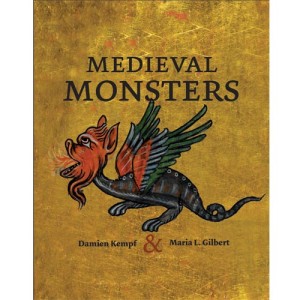Reviewer: Wouter van Dijk
Medieval Monsters, Damien Kempf & Maria L. Gilbert
The British Library, London 2015
ISBN: 978 0 7123 5790 6
Hardcover, lavishly illustrated in colour, with illustration credits
96 pages
£10 / €14,99
A procession of extraordinary creatures
Dragons, griffins, devils and demons. They all pass by in the beautiful little book Damien Kempf, Maria Gilbert and the British Library created, inspired by the marvellous imagery from medieval manuscripts. Even so, these four creatures are probably among the most well-known of all creations that can be found in the book that is just as exuberantly illustrated as some of its medieval sources of inspiration.
As a medievalist specializing in the study of medieval manuscripts and a writer and editor at the J. Paul Getty Museum Damien Kempf and Maria Gilbert seem an appropriate and complementary pair to write this book. Dedicated tot he imaginative creatures inhabiting medieval books, maps and scriptures, the whole book contains the most remarkable and astonishing creatures, drawn mostly from the collections of the British Library. Right in the beginning of the book the reader is introduced to the library’s thirteenth-century Psalter World Map, with a whole range of mythical beings inhabiting the outskirts of the known world. At first glance they seem quite human, but when one takes a closer look it strikes that one of them has a leg growing out of its mouth, another one doesn’t have a head but instead of that walks around with his face directly on his chest. An enormous chin or two pairs of eyes are other inconveniences these creatures have to deal with.
This physical deformity was typical for the presentation of creatures, monsters and other strange beings that were thought to live at the other end of the world or at places too hot or cold to live for humans. The Panotii for example, as Kempf and Gilbert tell, were known for their huge ears. These served as blankets on cold nights, but could also be used to fly away from strangers. They were rather shy, those Panotii.
Of course sea monsters also get their treatment, with the famous, or notorious, sirens appearing first. Interesting here is that sirens from medieval writings are not only presented as half-human half-fish, but also as half-human half-bird. The latter image didn’t survive into modern popular folklore however. Also worth to mention is the symbolism of the whale, which was known as a treacherous creature for its deceiving appearance as an island to unsuspecting sailors.
The Bible and legends about figures such as Alexander the Great proved to be especially rich grounds for the hunter of monsters and strange creatures in general. According to various medieval stories, Alexander encountered cyclopes and griffins on his journey to India for example. In the book as a whole, emphasis is laid on the Christian saints and their struggle against demons and the devil. Although this can be justified by the wealth of Christian imagery available in the medieval sources, it is a pity not more attention has been paid to regularly returning mysterious symbolism involving strange creatures in medieval illumination. Because biblical symbolism is quite commonly known, it would have been especially interesting to learn more about not so popularly known medieval imagery. Perhaps this is an idea for a future, more substantial publication.
As it is, the authors’ book primarily remains a picture book, be it a very beautiful one. The accompanying text gives an introductory overview of medieval imagery and symbolism. Be that as it may, the little book still contains more than enough to justify its purchase. Lavishly illustrated with the most exotic beasts, creatures and demons imaginable by the medieval mind, it also points out numerous medieval anecdotes in which monsters figure. For the reader the end comes far too quick as the beautiful images makes one hungry for more. Once arriving at the jaws of hell, as depicted in medieval scriptures that is, one arrives at the end of the book also. This is an appropriate ending for a book full of horrific monsters.
Wouter van Dijk

